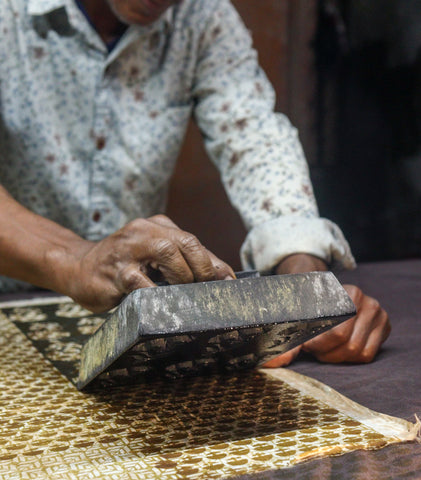Karomi CHHAAPA – the unconventional art of hand-block printing
Karomi CHHAAPA – the unconventional art of hand-block printing
The art of hand-block Chhaapa (printing) is not native to Bengal. It travelled from two western states of Gujarat and Rajasthan to the eastern state of West Bengal in the 1940s. Despite the fact that block printing is not a traditional art form in the state, the township of Serampore (situated at a distance of approximately 30 kms from the main city of Kolkata) in Bengal, soon became a centre for block printing activity and highly skilled local craftsmen quickly mastered this textile art. Due to a lack of historical lineage, Bengal’s themes and patterns were always different. Even back in the 20th century, Bengali prints were market-driven rather than traditional…thus making the prints from this region novel.
Born of the soil of Bengal, nurtured by the ethos of Bengali culture, it is this lack of traditionality that characterises Karomi Chhaapa (prints) found in a wide range of silk stoles, scarves and sarees.
The process of block printing at Karomi is long and tedious, but can be explained in a few simple steps:
It all begins with ideation in our design studio in Kolkata. Translating ideas into blocks with perfect repeats requires skill and expertise and master block cutters from Serampore undertake this rather daunting task. Generally, Sheesham wood, a teak tree native to India, is used to make these blocks.

There are usually three different kinds of blocks used for printing:
- The out-line block (Rekh)
- The block for the inner filling (Datta) and
- The one for the background filling (Gadh).
Traditionally, Gadh blocks are first dipped in colour and printed on cloth followed by the Rekh or outline block and finally the Datta or filling block.
At Karomi, we don’t have any such set rule for printing. In fact, we don’t have any rules at all.
‘The wonder of block printing lies in the fact that one can always bring in an individual element to it.’

With a view to expressing art through design, we often times use materials that don’t necessarily fall within the ambit of conventional block printing…for instance, our use of rollers to impart fascinating textures to cloth. With a distinct preference for geometrics as opposed to floral or folk themes, we use a variety of hand carved wooden blocks…a curious mix of old and new, simple and complex motifs and patterns. Inspired by the impressionist and expressionist artists, our use of colour is unusual…sometimes soft, like a Monet and at times bold, like a Matisse. ‘Print over print’ layering technique, whimsical randomness and broken irregularities describe the Karomi signature look…unencumbered…unfettered… fearless and free. In a sense, the ethos of Bengali chhaapa, of breaking away from the norm, elucidates our prints.
In this age of machines that pump out yards of fabric imitations every day, we create everything by hand. Karomi Chhaapa, filled with character and individuality, embodies skill and imagination…expertise and attention. The human touch is evident and picture perfect, with delightful small faults that a machine cannot duplicate.
When you invest in a Karomi Chhaapa, you contribute to the livelihood of an artist and a thinker – the ever so talented block-printer artisan - tucked away in some village or town in Bengal in India. You make an ethical fashion choice, contributing significantly to the reduction of carbon emissions.
We value the traditional know-how of hand-block printing and are committed to its preservation…as also its progression, and in the true spirit of Bengal, we innovate as we evolve.
Aham Karomi





